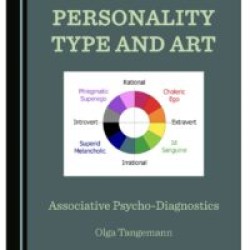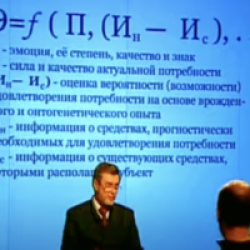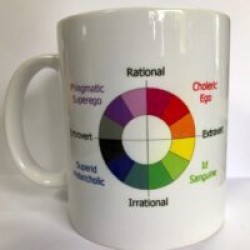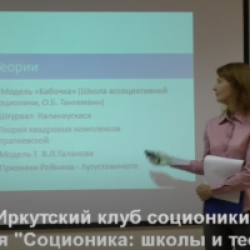This paper aims to describe socionics informational aspects and functions in the application to the theory of associative socionics.
Keywords: socionics, information, dichotomies, semantics aspects, preferences, type of psychic energy.
First of all I would like to be clear about what we mean by the aspect and function. The values of these terms are similar and therefore are often used synonymously.
It depends only on the point of view. In socionics literature one can find different definitions of aspects and functions, but essentially they all boil down to one and the same. If we refer to the human psyche, its structure and function, we speak of mental functions. If we consider the same characteristics apart from the mind, then we have a view of the aspects of information that describe not the human psyche but objectively given reality.
Founder of socionics A. Agustinavichute in her work “On the dual nature of man” under the functions understand the strengths and weaknesses of the psyche, namely, “the ability of a person to understand certain aspects of the world” (1). In socionics, there is another name for the function: elements of the human information metabolism. Information aspects represent all information about the world and relate to the eight elements of information metabolism. With the information aspects we associate the eight functions: sensory of power, sensory of sensation, intuition of doubt and intuition of insight, theoretical logic and business logic, ethics of relationships and ethics of emotions. Functions are divided in turn into introvert and extrovert, rational and irrational, static and dynamic. These additional features are not functions, although they also like the 4 basic functions of C. Jung (thinking- feeling – sensing- intuition) tell us about the properties of the psyche. (2)
Why is so? Jung himself pointed out the distinction between the four basic functions and the dichotomy of extraversion – introversion, defining the last not as a function of the psyche, but the orientation of the mind to the external (objective) and internal (subjective) world of man (3). In addition to extraversion and introversion Jung distinguished properties such as rationality and irrationality, which correspond with the judgment or perception. In socionics, besides dichotomies mentioned above, are also used 15 typology attributes known as Reinin dichotomies (4), which can be also described in terms of information aspects.
In the theory of associative socionics dichotomies extraversion- introversion, rationality – irrationality and statics – dynamics are basic and do not serve to determine the psychological type, but to determine the type of psychic energy (TPE). Since TPEs define the four basic groups of socionics typology, we use three basic dichotomies to relate the person to the one of the four group of types : Ego-types Superego- types Superid types and Id-types. (5)
The names of the four groups were borrowed from the personality theories of S. Freud and C. Jung. Each of the four TPEs is associated with a pair of informational aspects or functions. In order to determine the personality type, it is necessary to identify which pair of functions is most clearly manifested in the human psyche. These pairs of functions in associative model correspond to the model A, namely, they occupy the positions of program and role functions in the mental ring of model A.
Each of the 8 functions of the psyche perceives and transmits only inherent energy it possesses, and the person is a carrier and a spokesman for a certain type of psychological energy (TPE). Each TPE is defined by a pair of socionics functions and corresponds with a group of types. This is not regarding quadras or interest groups but the small basic groups of socionics typology. For example, the functions of ethics and logic relations (Fi and Ti) are introverted , rational and static. To include a person to a TPE group, diagnostician identifies what values prevail in the client preferences and to which pair of functions these values relate.
– For Superego group – functions of logic of relations and the ethics of relations.
– Ti (white logics ![]() ) – structural logic are associated with rules, principles , thoughts, cause-and- effect relationships, the developing of own logical assumptions that are focused on the subjective understanding of the issue that may diverge from the objective data or the fact.
) – structural logic are associated with rules, principles , thoughts, cause-and- effect relationships, the developing of own logical assumptions that are focused on the subjective understanding of the issue that may diverge from the objective data or the fact.
– Fi (white ethics ![]() ) or the ethics of relations – moral norms, morality, focuses attention on another person needs and requirements.
) or the ethics of relations – moral norms, morality, focuses attention on another person needs and requirements.
– For Superid types – functions of doubt intuition and sensory sensations.
– Ni (white intuition ![]() ) – intuition of doubt, imagination and time.
) – intuition of doubt, imagination and time.
– Si (white sensation ![]() ) – the sensory of sensation, perception of space and comfort.
) – the sensory of sensation, perception of space and comfort.
-For Id group – functions of intuition of insight and sensory of power.
– Ne (black intuition ![]() ) –possibilities, guesses, “cross-sectional” holistic vision of the image as a static picture; emphasizing the essence of the object and its hidden potential.
) –possibilities, guesses, “cross-sectional” holistic vision of the image as a static picture; emphasizing the essence of the object and its hidden potential.
– Se (black sensory ![]() ) or sensory of power – physical interaction, playing, freedom of movement and spatial distribution , the impulse to liberation, appearance and attractiveness, ease in pursuing of the space to satisfy the desires and instincts.
) or sensory of power – physical interaction, playing, freedom of movement and spatial distribution , the impulse to liberation, appearance and attractiveness, ease in pursuing of the space to satisfy the desires and instincts.
For Ego group – functions of the business logic and ethics of emotions.
– Te (black logics ![]() ) or business logics – goal setting, a reasonable approach to the work, the rationality of behaviour, technology, methods, and the efficiency of what needs to be done.
) or business logics – goal setting, a reasonable approach to the work, the rationality of behaviour, technology, methods, and the efficiency of what needs to be done.
– Fe (black ethics ![]() ) or ethics of emotions – a demonstration of emotion, freely expressing emotional states in public.
) or ethics of emotions – a demonstration of emotion, freely expressing emotional states in public.
Aspects of intuition
I would like to describe in more detail aspects of intuition, since by virtue of abstraction of these aspects some of us have difficulties with identifying and differentiating between two types of intuition.
Ni is the intuition of doubt, apprehension, imagination, flow of mental and sensory images. It is also the intuition of time. Often referring to the past.
Ne is the intuition of insight and the moment of truth, real-life opportunities, the intuition of a single whole image (essence), intuition of present and future.
Most doubters and dreamy types are Ni-types – Intuitive Ethical Introverts and Intuitive Logical Introverts.
Most confident and resourceful are Ne-types – Intuitive Ethical Extraverts and Intuitive Logical Extraverts.
Why is that? While Ni –types reason and think often referring to the past Ne-types are more preoccupied with the thought of the present time and the future. Events are described by Ne-types as either real or highly probable with no doubt. The individual express his understanding of the events either in static or dynamic terms, respectively, with the reference either to present or to the changes in the past and in the future.
Ni is not just intuition of time because time is a general criterion inherent to both Ni and Ne. The existing definition of Ne as the aspect of possibilities is wrong too. Opportunities are considered from the perspective of Ni- and Ne –types with the difference that Ne-types consider the existing opportunities here and now. This is why they quickly generate opinions, make decisions and instant choices. For Ni-types it is not easy to make the decision here and now, they are afraid to make the wrong choice. Ni-types are more likely to miss the chance than to take it. They tend to remember the past, the lost opportunities and fantasize about the future .
I would like to clarify how I came out with the refinement of aspects of intuition based on my practice of typing people. Let us consider the static and dynamic perception in general. Ne belongs to static aspects. Static is expressed in the single-step condition (yes or no) and is correlated with the photographic image, which appears as a picture in front of the eyes. In the picture the reality is frozen. There is no need to go mentally into the future or the present to reveal what is in the picture. Also there is no need to invent something extra, imagine and embellish. Result of the pictures is a static description of a single moment in time.
Ni types have a very different perception of the reality as on going process of evolution. They do not perceive the world and themselves in terms of a permanent picture in front of eyes. On the contrary, the picture’s movement makes eye to switch between items, losing the sight of the integral image, as if they watch the process of the object transformation or a film. There can be no single unchanging image for Ni-types because everything flows and constantly changes.
When ILE (Ne-type) tells very confidently his opinion about something, immediately appears Ni- type, which begins to doubt any assertion and any static image as the truth. In the mind of the Ni type there is no truth if the changes in time are not accounted for. Ne-perception of the world seems limited and inadequate to him.
This phenomenon of confrontation or restricting each other’s views is described in the Model A: the program and restrictive functions limit each other with criticism. This is what we call the conflict between the functions within the psychic structure. It emphasizes the psychodynamic nature of the processes within the psyche. It exists on each level and in each block of the model A and associative model respectively.
Static functions of perception ( Ne, Se) are directed to what happens here and now in the immediate environment with the difference that Ne is focused on general view (abstract )and Se is interested in details (concrete). When we talk about possibilities as Ne attribute we mean real or highly probable events which come from insight. Ne- types do not think in terms “what if” because they miss the whole process of inference and it seems as unnecessary to them. Why to dwell on things while you already know what is what and how it should be? Ne-types either have the answer or not but will not like to doubt about it and especially aloud. They would rather wait until the get insight about it.
For Ni – type is on the opposite as if they cannot stop doubting and once they managed to make a decision or choice they feel that they have achieved something. ILI was telling a story of walking in the shop for hours and walking out empty handed is perceived as natural. If Ni-types were able to do what Ne-types can, their rich inner world of creative imagination would not be claimed.
Ne- thinking style can be compared to a puzzle: parts of the structure quickly add up together into a coherent image . The work of the doubt intuition, on the contrary, is a game of imagination, where the focus is constantly shifting in the direction to the individual parts, making it impossible to cover the whole picture. As soon as the image becomes more clear, it immediately breaks again and flows in a different way with a fuzzy structure and vague facets.
Ni –types could swim endlessly in their mental images, never stopping on one option, because it is not interesting. They like to share with others their thoughts and tangled feelings, their doubts. This is how Ni- perception works, which can be compared with the work of the artist.
Program Ne-types, on the contrary, seek to escape from doubt and the thought process which reminds going round in circles. They search for information and find the way out and make a choice. This process is accompanied by the natural belief in themselves and what they say. Often overestimate themselves or at least appear to others as being overconfident or even ignorant, and cocky know-alls . Don Quixote (ILE) would not be Don Quixote , if he did not believe in his ability to find the only correct answer to all questions , learn everything (or almost everything), and would not share the knowledge with others. They think that they know the truth in the first instance and therefore often “turn up their noses.”
Aspects of rationality
Rationality in socionics corresponds with rational functions of judgment – with the function logic (thinking) and ethics (feeling). Human judgment can be objective or subjective; abstract or concrete. Let us first consider the question of what lies beneath the difference of objective and subjective judgments and what information aspects have consistent signs of objectivity and subjectivity in the theory of associative socionics.
People who judge objectively base their judgement on logical reasoning, knowledge of the laws and facts, common sense, namely, the material that is clear and obvious to most people. The judging may be perceived as subjective if it is based on personal experience, does not make reference to the general facts and laws or distorts them with the reference to feelings and emotions.
Logical types tend to refer to causal relationships, , facts and general patterns. Ethical types tend to make reference to their feelings and the feelings of others. Accordingly, logical and ethical types have different language to express their thoughts. But we should not believe that ethical types are always subjective in their views and logical always objective. Ethical types can feel the injustice of inferences, but are not able to logically prove their point. Knowledge expressed by the ethical type often seems unconvincing for the person who came the conclusion by means of logical thinking. Therefore, to hear each other, we should try to express our thoughts and feelings in the form acceptable to the other person which is not an easy task to do.
If you want to convince a logical person or just to change his opinion you should look for an logical argument that is good enough for him to reconsider the judgment. Otherwise it will not work and you opponent will not be able to understand you. Logical types evaluates you and what you are saying from the logical standpoint. If you are not talking his language there will be less trust in you and your abilities. Logical person less worry about the impact he may have on the opinion or the feelings of others, and if he is ethically correct. You can recognise the logical types by their ability to assess feelings of people around them and read adequately their emotions.
Ethical types may find logical arguments very helpful. Acting with the best intentions, ethical types sometimes come to unexpected negative consequences for themselves, because they do not track the cause-and- effect relationship of their actions and do not reflect on the objective laws. Thus, in practice, we often observe that the objectivity of judgment is more characteristic for the logical types , and subjectivity – for ethical.
Both group of types use their logics and ethics while trying to reach understanding and work out a compromise but logics or ethics will always prevail. The more you communicate with different types the more you notice the personality preference. Second aspect that compensates first, is less noticeable. It also becomes apparent that the logical judgement in ethical types has a different quality and different orientation, which can be called “ethical logic”. Ethical logic differs from the “actual logics”. The converse is true for the logical type trying to express themselves in ethical terms – “logical ethics”.
Aspects of irrationality
Irrationality correlated with irrational functions of perception: intuitive state and sensory feeling (sensations). Perception can be specific, concrete (sensory) and abstract (imaginary, intuitive).
The main difference in the perception of sensory and intuitive types is that the attention is either on the concrete objects, details of material world or on the abstract issues and questions which have got nothing to do with immediate environment. The language of sensory types is more simple, less extravagant or complex. They talk about things down to earth, do not like vague answers, unusual words, complex terminology. They describe the objects and events as they see think, see and feel them. The intuitive perception slides on the surface of an object , grasping the general outlines and creating a chain of similar images, which we call associations. While sensory type keeps focus on any one subject or issue, intuit flows smoothly from one question to another as new associations arise.
Beginning and the end of story for the intuitive types can be very different and the person will not remember how he came with issues that have nothing to do with his original topic of discussion. Moreover, after spending the whole evening and talking on various topics, intuit may never finish his thought or story. To establish good relationship with an intuitive type the sensory type must learn to be patient; not to yawn while listening; not to be distracted by what ‘s going on; not to interrupt with suddenly coming to mind questions; and remind of what has been said before the intuitive type has lost the thread of conversation.
Sensory type may find difficult to follow the intuitive thought and prefer to think and to talk about practical issues. When you are talking to a sensory type you should avoid ambiguity, be direct and express your thoughts succinctly. Concrete and abstract perception can be observed in the judgments of sensory and intuitive types. Sensory (concrete) judgment is based on sensory perception and opposite is true for intuitive (abstract) judgement. By analogy with the ethical logics and logical ethics we can also consider the border areas and aspects of sensory intuition and intuitive sensory.
Rationality – is primarily a judgment. Judgment can be both objective (logical) and subjective (ethical). Irrationality – is primarily perception (state), and it can be either abstract (intuitive) or concrete (sensory).
Objectivity – subjectivity
In socionics there is different view on dichotomy “objectivity – subjectivity”. Objects and objectivity can be associated with extraversion. Subjectivity is an attribute of introversion or the orientation of the attention to the relations between objects. This means that the extraverted functions are considered to be associated with the perception of objects and introverted with the perception of relations or fields. . You could think that dichotomies of objectivity and subjectivity can not be simultaneously correlated with extraversion-introversion and logics-ethics. In fact, there is no contradiction, since we are talking about different perspectives. Objectivity as a manifestation of the logic is different from the objectivity as a manifestation of extraversion.
Statics- dynamics
Now we could overview the concept of dichotomies statics- dynamics. The word “static” comes from the Latin “status” – state of affairs from the point of view of the law. Dynamics – the state of the movement, the course of development, the change of a phenomenon influenced by factors affecting it (6). If we highlight the essence, the static – it is a state of rest, immutability, stability, result. Dynamics describes a process, interaction, change. Definition of statics- dynamics point first of all to a certain state of objects either stable or moving. The state relates semantically to perception ( irrationality) and not a judgement ( rationality). This means that the dynamic and static is primarily perception and the judgment is the derivative of the perception.
Thus, each of the eight socionics functions can be described by three main dichotomies as follows:
Ne (black intuition) – extraverted, abstract, static perception.
Ni (white intuition) – introverted, abstract, dynamic perception.
Se (black sensory) – extraverted, concrete, static perception.
Si (white sensory) – introverted, concrete, dynamic perception.
Te (black logics) – extraverted, objective, dynamic judgment.
Ti (white logics) – introverted, objective, static judgment.
Fe (black ethics) – extraverted, subjective, dynamic judgment.
Fi (white ethics) – introverted, subjective, static judgment.
Semantics of information aspects.
To determine the type you need to know the semantic content of the information aspects. If a person feels comfortable dealing with you he will be more open to say what he fancy, what is interesting and understandable for him. Russian proverb: “One talks about that hurts” is suitable for talking about semantics of the information aspects.
Se – sensory of power
Representation of will as a freedom of mind and body, freedom of action, willpower, will to aquire the space; willingness to overcome obstacles and persistence, ability to mobilize, stability, a sense of ownership; desire, want / do not want, will to win, volitional quality , evaluation and demonstration, the ability to assess the balance of forces (force of the enemy and its ability to resist, to take a position), ownership, possession, money, appearance, beauty, sexual attraction. Stopping or pushing actions agility and quick reflexes, seizing the initiative, confrontation, engagement, impact, expansion, pressure, attack, aggression, violence, protection, defense, resistance, retreat, build strength, power influence, expansion .
Si – sensory of sensations
Sensation (heat / cold, chills); body position in space (comfort, convenience, cosines); perception of surfaces through touch (texture, smooth-rough), sight, hearing, smell, taste; physiological processes (fever, sweats, chills, hunger, nausea, dizziness, etc.); health, body and organs, diseases and their symptoms, physical pain, rehabilitation, treatment, medicine, spa, health centre, recreation, relaxation. Aesthetics, cleanliness, neatness, kitchen, cooking, food, Epicureanism, pleasure, enjoyment, flavour; colour shades and combinations. Stroking, touching, feeling, cooking food.
Ne – Insight intuition
Momentary inspiration, unexpected insight, extrasensory power, ideas, perspectives, truth, eureka, discovery, originality and innovation, genius, mystery, guess, the beginning, wonder, being nosy, surprise . Stem, core, grasp the essence of what is happening, awareness of the hidden potential, abilities and talents; perception of the whole and the relationships between parts of the whole, content, meaning, insight, alternatives, options, real-world opportunities. advertising, spreading the ideas, innovation, selection, search, curiosity, self-confidence, erudition, giftedness, transformation, reconstruction.
Ni – Intuition of doubt
Vague misgivings , imagination,fantasy, a dream, an illusion, memories, past and future; change and development over time, evolution, change of seasons, day and night, age-related changes, forecast, foresight, premonition, destiny, fate, events, plot outline, the process, speed, acceleration, rhythm, tempo, slow, timeliness, sense of time, abstract thinking, escape from reality.
Te – Business logic
Facts, evidence, statistics, experimental verification, measurement, results , objectivity, management, benefits, efficiency in actions, goal-setting, planning, business activities, reasonable steps, tasks and their performance, work, labor, skills, qualifications, profession, experience, organization, system approach, object, object delivery, employment, turnover; industry, economy, finance, cost, price, production, factory, manufacturing process, the operation; quantity and quality instruction, the algorithm mechanism, mechanical, engineering, technology, design, method.
Ti – Formal logic
Objective relations, ability to reason and judge, to be right, truth, rules and principles, norms and standards, law and order, constitution, structure, hierarchy, classification table, logical, categorical thinking, explanation, causal link (“if-then”), the criterion, the category, relativity and schematic judgments; principled judgments (“yes / no”); rigor, clarity, consistency of judgments, inference; logical operations, methods of reasoning, value, comparison, analysis, synthesis, deduction, induction, conclusions, sequencing, modelling; formal, objective attitude, terminology, definition, attribute, symbol, sign, date, language, vocabulary, word, theory, theorem, argument, justification, commitment, code, statute, correlation, identification.
Fe – Ethics of emotions
Expression of emotions. Delight, joy, sadness, anger, anxiety, agitation, excitement, panic, anxiety, fear, despair, admiration, hatred, resentment, crying, laughter, hysteria, temper, scandal, passions, depression, melancholy and suffering; strength, sincerity or artificiality of emotions, intonation, artistry, show, concert, theatre, acting, game of emotions, masquerade, spectacle, adrenaline, mood, charisma, experience, emotional state. Speech superlatives (awful, ugly, creepy, disgusting, awesome, gorgeous, huge, runaway, etc . Cry, inspire, impress, shock, shout, pretend, manipulate with emotions, persuade and motivate, create an emotional background, bewitch, enchant, colourful and fiery talk.
Fi – Ethics of relations
Relationships between people. Subjective feelings, the relation of man to anyone or anything. Etiquette, sensitivity, compassion, love, forgiveness, respect, friendship, affection, tenderness, devotion, loyalty, caring, tolerance, gratitude, humanity, courtesy, tact, kindness. Morality, moral standards, good and evil, ideals, mutual aid, charity, faith, hope, honor, dignity, moral duty, responsibility, self-criticism, religion, sin, condemnation of evils, hatred, hypocrisy, meanness, treachery , conspiracy, condemnation, resentment, sympathy and antipathy, moral evaluation (“like / dislike”, “good / bad”). To forgive, to love, to sacrifice, to believe, to hope, to care, to repent and feel sorry.
Table 1: Descriptions of the semantics of the information aspects. In certain aspects, the information is partially used from descriptions of functions of V. Blokhin (7).
| Intution |
Intuition of doubt |
|
If I’m in doubt or day dream – I am alive. “To be or not to be: this is the question” – a line from Hamlet’s soliloquy in William Shakespeare’s tragedy. Intuition of doubt and vague premonition manifests in the vivid imagination, dynamic perception and artistic inclinations. Favourite hobby for Ni-types is to live in the world of the phantasy, not in the present moment. They tend to repeat themselves a lot while telling stories and transit on extraneous. As the result they may feel that they missed on something important or did not have said enough. This process may also go silent in their mind. If Ni-types ask for advice it is just their wish to express their doubt on the topic in question. If you try to offer solutions it will simply don’t work because any solution is a reason for a new doubt. There is nothing to surprise them as they believe to know it all. They rather want you appreciate their ability to undermine any solution and agree that there is no quick fit. It is much more useful for them to find the answer themselves, because they often doubt the answers of others and often change their minds. Ni-types usually think in terms “what could be their life now, if they could change their past to the better”. Feeling of incompleteness and uncertainty is a natural state for them and they would rather stay where they are than to accept a quick way out. Ni-types are able to track subtle changes and like to warn others about the possibility for a negative outcome which may be understood by others as criticism. Position of waiting, indecision and insecurity is associated with playing a victim of circumstances. They may not want to take action and control on the situation. They need positive encouragement, friendly support, understanding and empathy from others. Intuition of doubt is known also as intuition of time. Ni-types can fall easy out of the real-time while day-dream and at the same time they can see into the future and make realistic predictions based on observation and thinking. |
- Augustinavičiūtė A. “A the dual nature of man”. – Kiev: Publishing House of the International Institute of Socionics, 1997 – 9с.
- Storr A. The Essential Yung. London: Fontana Press. – 1998
- Psihologos. Encyclopedia of Applied Psychology. “Introversion – Extraversion according to Jung.” [Electron. resource].
– http://www.psychologos.ru/articles/view/introversiya_-_ekstraversiya_po_yungu - Reinin G Reinin dichotomies. [Electron. resource]. – Mode of access: http://reinin.ru/
- Tangemann O.B. Associative typology. Socionics, Mentology and Personality Psychology, 2010, № 4, p. 65 – 70; Number 5, p. 77 – 82
- Wikipedia about the dynamics and statics. [Electron. resource]. http://ru.wikipedia.org/wiki/%D0%94%D0%B8%D0%BD%D0%B0%D0%BC%D0%B8%D0%BA%D0%B0
- Blokhin W. [Electron. resource].: http://harmony-club.ru/tests/?tid=blokhin&viewinfo=yes










4 Responses
[…] nothing and wasting time. Preference is given to practical activities and manual work. Source: Information aspects – School of Associative Socionics very well. nonetheless, you have not responded to it well you called laziness a […]
[…] Подтип ТИМ Чтобы определить подтип на уровне 16 типов информационного метаболизма, необходимо знать показатели по 4 функциям: мышление (логика), чувство (этика), ощущение (сенсорика) и интуиция. Если вы знаете сильные функции (например, логика и интуиция), и ведущую группу ТПЭ (н-р, Суперэго), то тип определяется автоматически, так как он лежит на пересечении ТПЭ и ТИМ: ЛИИ — логический интуитивный интроверт. Если вы знаете, подтипный TПЭ (например, Суперид), то можно автоматически вывести подтип ТИМ — ИЛИ — интуитивный логический интроверт. Если вы не знаете значение функций и признаков, то ищите недостающую информацию в статье «Информационных аспекты». […]
[…] вы можете найти только в моей теории и практике. 1) http://socionics4you.com/post-1496 2) http://socionics4you.com/post-1283 3) http://socionics4you.com/post-35 Это теория […]
[…] и не знаете, что означают термины, то обратитесь к статье о информационных аспектах, где подробно описывается смысловое содержание […]